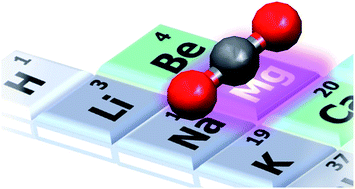Magnesium-based systems for carbon dioxide capture, storage and recycling: from leaves to synthetic nanostructured materials†
Abstract
A steep rise of carbon dioxide level in the atmosphere is one of the main causes of global warming. This increase is ascribed to the fact that, since the beginning of the industrial revolution, natural processes for CO2 sequestration are no longer able to cope with the excess of CO2 produced by anthropogenic activities. In recent years, research has been focused on defining artificial CO2 cycles to support the natural one. The element magnesium is used in this review as leitmotif to explore the majority of systems involved in each step of the natural and artificial CO2 cycles (separation, storage, sequestration or recycling). Magnesium is in fact ubiquitous, being present in the mesosphere as global layers, on the Earth's surface in the most important enzyme for carbon fixation (Rubisco) and in silicates that constitute the major part of rocks, where CO2 is sequestered through natural weathering. For what concerns synthetic materials, zeolites, metal-supported particles and metal–organic frameworks are only a few of the systems considered in the literature. The intent of this review is to connect different fields of study to create an interdisciplinary review in the chemistry domain. Research outlooks are suggested for the different fields. In the end, a qualitative analysis of the advantages and limits of different processes and a rough estimate of their potential are given in terms of the time needed to reduce the atmospheric CO2 level. Although economical, political and health evaluations would be also necessary, this analysis indicates that forestation could be a possible winning solution in the short-middle term for lowering the atmospheric CO2 concentration.


 Please wait while we load your content...
Please wait while we load your content...